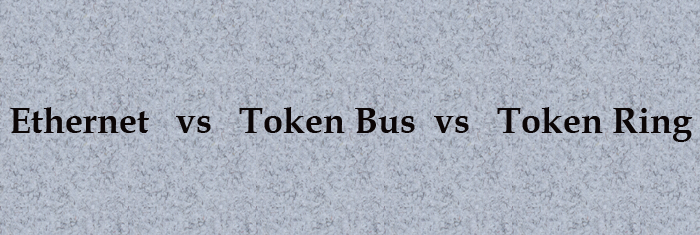Ethernet vs Token bus vs Token ring In Computer Networks.
Hello friends, In this blog post(ethernet vs token bus vs token ring) we are going to let you know about What is the difference between Token rings and Token buses? What is the difference between Ethernet and Token Ring? Why is Ethernet better than Token Ring? What are the disadvantages of the Token Ring?
See the quick Q&A related to them to understand them better in detail below:
What is the difference between Token Ring and Token Bus?
In the token bus network, the token is passed in a virtual ring whereas, in the token ring network, the token is passed into a physical ring.
The token bus network is defined by the standard of IEEE 802.4 and the token ring network is defined by the standard of IEEE 802.5.
What is the difference between Ethernet and Token Ring?
Token ring is an IEEE standard 802.5 whereas ethernet is a standard of IEEE 802.3.
In the token ring, there is a station and a special frame that is called a token.
If any station has the token then it can transmit the data in the network. Ethernet uses the CSMA/CD mechanism.
If there are many stations to communicate in the network then all stations will be stopped to transmit the data packet.
They all will wait for a random time and then will again check the idle line and if the line is clear then they will transmit their data packet.
Ethernet does not work on priority like a token ring. Ethernet is less costly than a token ring.
Why is Ethernet better than Token Ring?
As a general rule, 100M bit/sec Ethernet will be several times faster than the 16M bit/sec token ring.
Ethernet is much cheaper than the token ring. Ethernet works on the mechanism of carrier sense multiple access/ collision detection(CSMA/CD).
What are the disadvantages of the Token Ring?
There are various disadvantages of the Token ring network which are given below:
In this case, if one workstation gets slowed down then the entire network may collapse or shut down.
The transfer of data must pass on to each network’s workstation.
A small disturbance in the network can cause the failure of the whole system.
Hardware is essential to connect each workstation in the network.
Till now we have seen some important questions and answers regarding Ethernet, token rings, and token buses.
Now we will discuss them one by one individually.
Ethernet(802.3):
Ethernet is far and away from the most widely used type at present, with a huge installed base and considerable operational experience.
The station can be installed on the fly without taking the network down.
Ethernet is non-deterministic which is often inappropriate for real-time work.
It has no priorities.
At a high load, the presence of collision becomes a major problem and can seriously affect the throughput.
Delays at low load are practically zero(Station does not have to wait for a token; they just transmit immediately).
Ethernet has a substantial analog component. Modems are not required.
Due to the possibility of having frames aborted by collisions, the minimum valid frame is 64 bytes.
Token Bus(802.4):
Token Bus uses highly reliable cable television equipment.
A token bus is more deterministic than 802.3.
The token bus supports priorities and can be configured to provide a guaranteed fraction of the bandwidth to high-priority traffic such as digitized voice.
It has excellent throughput and efficiency at a high load.
It has a substantial delay at a low load(Stations must always wait for the token, even in an otherwise idle system.)
Token Bus uses a lot of analog engineering and includes modems and wideband amplifiers.
It can handle short minimum frames.
Token Ring(802.5):
Token Ring uses a point-to-point connection.
It is also deterministic.
Similar to the token bus, priorities are possible, although the scheme is not as fair.
Throughput and efficiency at high loads are excellent.
There is always a delay at a low load because the sender must wait for the token.
A token ring can be fully digital.
Like the token bus, short frames are possible but unlike the token bus, limited only by the token holding time.
Conclusion:
Using this blog post we have gone through What is the difference between Token Ring and Token Bus, What is the difference between Ethernet and Token Ring, Why is Ethernet better than Token Ring, What are the disadvantages of a Token Ring, the difference between ethernet token bus and token ring, the difference between token bus and token ring in a computer network.
You can also go through the extensive blog related to the token bus, token ring, and ethernet.
You can also go through a few more amazing blog links below related to computer networks:
Need Of Network Layer In Computer Network…
What Is Wireless LAN In Computer Networks…
What Is Bluetooth Network…
FDDI Network In Hindi…
What is Token Ring(802.5) In a Computer network…
What is a token bus in the computer network…
What is Ethernet In Hindi…
Compare Ethernet802.3, Token Bus802.4…
CSMA(Carrier Sense Multiple Access In Hindi) In Hindi…
What is the design issue of the network layer…
In the case of any queries, you can write to us at a5theorys@gmail.com we will get back to you ASAP.
Hope! you would have enjoyed this post about the comparison between Ethernet, Token Bus, Token Ring, or 802.3, 802.4, and 802.5.
Please feel free to give your important feedback in the comment section below.
Have a great time! Sayonara!


